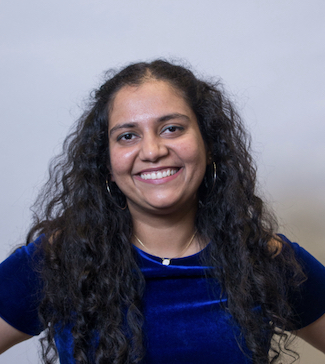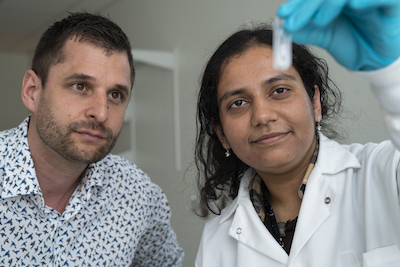Although George Mason University doctoral student Shrishti Singh may have faced setbacks, including a pandemic, during her time in the bioengineering PhD program, she didn’t let it get in the way of her dreams. With the support of her Mason mentors, she has achieved her goal of developing a promising new technology that would allow cancer to be visualized in deep tissue and perhaps diagnosed earlier.

Using a combination of FDA-approved dyes and photoacoustic imaging, Singh has created an injectable dye that attaches to tumor cells and increases the contrast of those cells against the background tissue. Photoacoustic imaging, a new biomedical imaging technique, then illuminates the cancer cells, even in early stages and deep tissue areas of the body.
“This technology gives patients better diagnostics for colon cancer, pancreatic cancer, breast cancer, and more, and can improve their prognosis,” said Singh, who has a master’s degree in biomedical engineering from the University of Bridgeport in Connecticut and an engineering degree from Ramaiah Institute of Technology in Bangalore, India.
Singh said she credits her advisors, Mason bioengineering professor Remi Veneziano and mechanical engineering professor Jeffrey Moran, for her success and perseverance.
“After the first year of my PhD, I had almost given up on my degree,” said Singh. “When Professor Veneziano became my advisor, he lifted me up. He has given me the confidence to be where I am today.”
She added, “And Professor Moran has helped me with a lot of the logistics of my degree and directing me on how to achieve my goals.”
When Singh first started working with Veneziano, she told him her main goal was to work on translational technologies that “make it from the research bench to the bedside of the patient,” she said.

Veneziano supported her vision, and Singh has spent her PhD not only developing the technology, but ensuring that it is simple and reproducible.
When Singh encountered roadblocks in her research, she said Moran and Veneziano offered two different research perspectives to help her find the best solution. And what was most important to Singh, when things got hard, they supported her.
“In my PhD, I’ve struggled so much with who I am,” she said. “I’ve had people tell me that my kindness and empathy will not get me where I want to be in science, and that was really hard for me.”
Both Veneziano and Moran have since taught her that those people were wrong.
“Working with a new professor takes courage and trust, and I am honored that she put her trust in me,” said Moran. “Shrishti is one of the most resilient, self-motivated, and caring people I have ever met. She is an inspiration to us all.”
“Professor Moran’s greatest advice has been that no matter what is happening around you or what people say, take the opportunity for growth, but don’t change who you are inherently as a person,” said Singh.
And when rejection gets overwhelming, Veneziano advised Singh to take it one day at a time and ask herself “what did I achieve today?”
“Shrishti has an extremely high work ethic,” said Veneziano. “She is dedicated and has a passion for science, and she wants to work on projects that have a positive impact on our society.”
The technology Singh has created also has many other uses that she hopes to explore in the future. For example, it could also be used for surgeons to better visualize the margins of a tumor during surgery.
After graduation in December, Singh hopes to turn her technology into a successful company. With support from her advisors and Amy Adams, executive director of the Institute for Biohealth Innovation, Singh will seek funding for a post-doctoral program and apply for grants to fund more research on her project.
“This experience has shown me the true power of Mason,” says Singh. “I look forward to building more confidence in my work to inspire others on what I do and why I do it.”
Read More Stories
- November 24, 2025
- October 28, 2025
- October 21, 2025
- October 14, 2025
- August 22, 2025
